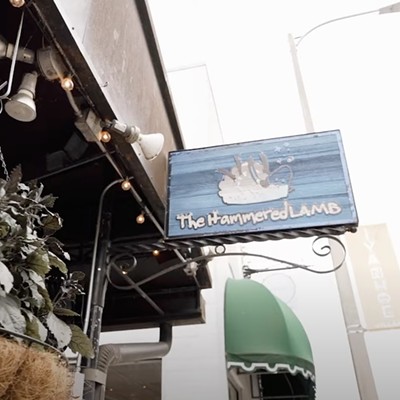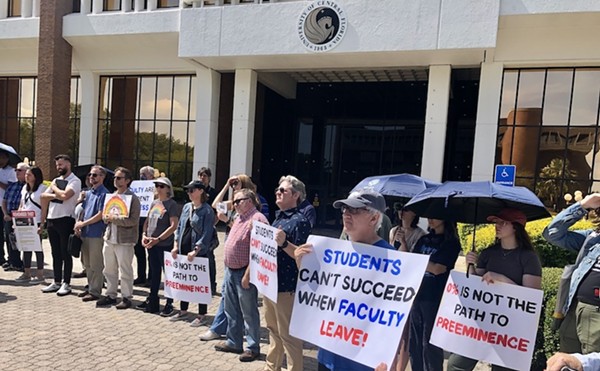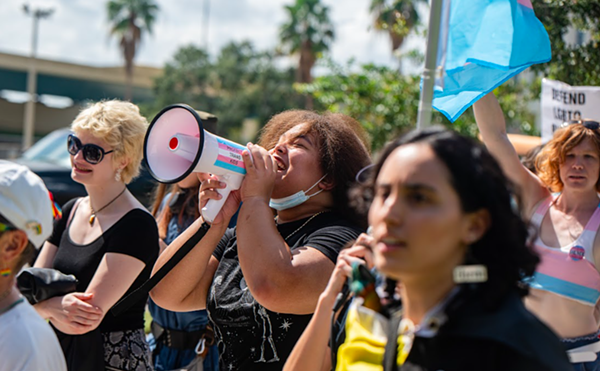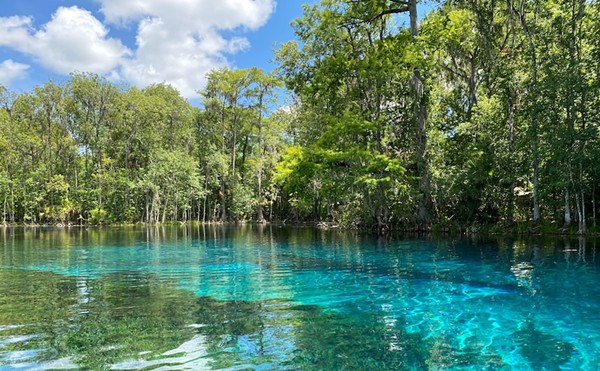In the looming shadow of downtown Orlando’s metropolitan dreams – the Erector Set sways of slow-moving cranes, the hollow skeletons of dark-windowed condos – a Tuesday-night call to arms comes to order in a fifth-floor conference room in the 15-story Fifth Third Bank building. You wouldn’t know that, right here, history is being made.
And God, is it boring.
A volunteer log sheet is passed to the eight people seated around a mahogany conference table. There’s discussion of organizational schemata. There will be steps and interim steps. Interviews need to be set up. Website hits are up. Somebody found an old blue silk baby bonnet.
This is the Lake Eola Heights Historic Neighborhood Association’s first foray into the city’s 2008 Mayor’s Matching Grants program. In this case, the city is supplementing the association’s $25,000 in in-kind donations –donated meeting space, recording facilities and consultants – with $5,000. With this money, the residents of Lake Eola Heights want to create an oral history of the century-old neighborhood, culminating in a DVD and an exhibit at the Orange County Regional History Center at the end of the year.
Time is of the essence, because some of the neighborhood’s older residents may not be around much longer, and the history of Lake Eola Heights might die with them. While the recent real estate boom brought in its share of well-to-do professionals, the presence of the old-timers still anchors the historical community.
“It’s important to do it now, because if you wait 10 years, many of these 70-year-old people will be moved away or no longer here to tell us anything,” says attorney David Moffett, the project’s leader. “It could have been done 10 years ago even better, I would say.”
Former Mayor Glenda Hood launched the matching grants program in 1994, borrowing from similar programs in cities like Charlotte, N.C. Previous Orlando matching-grant projects have included educational programs, faith-based initiatives, historical signage and landscape improvements. And while there have been some attempts at divining a neighborhood’s history – the McFall Neighborhood Association’s “Discovering the Past/Celebrating the Present” focused on education and neighborhood history in Parramore in 2004 and 2005 – the Lake Eola Heights project is the first to do so on an audiovisual basis.
The neighborhood has a story to tell. Association president David Martens has witnessed Lake Eola Heights’ history firsthand. He was the neighborhood association’s first president, in the mid-’80s (a position he resumed last year). In 1977, he and his wife Diane purchased their house on Amelia Street for $33,500.
“We had a real love for `the neighborhood` and were seeing it continue to decline,” Martens says of the late ’70s. “Boardinghouses were everywhere. Commercial intrusion was eating away at the borders.”
That wasn’t always the case. In 1913, the neighborhood – sandwiched between Robinson Street and Colonial Drive just east of downtown – consisted of a sparse sprinkling of midsized homes and a shelter for tuberculosis sufferers. There was a housing boom in the Roaring ’20s that produced many of the historic homes that characterize the neighborhood today. In the 1950s, Lake Eola Heights had a strong Catholic presence and encompassed the St. James parish school, the Catholic Daughters of the Americas lodge hall and St. Joseph’s convent.
Lake Eola Heights had declined considerably by the early 1970s. Many of the area homes were chopped up into rental properties; others were taken over by a growing transient population. Blight had all but swallowed its history.
Martens and his fledgling association fought back. In the late 1980s the city recognized the neighborhood as historic. It became the first Orlando neighborhood to earn a place on the national historic registry, which helped fend off developers. Today, thanks in part to the restrictions that go along with the historic designation, Martens’ house is worth more than $500,000. Other neighborhood homes have enjoyed a similar trajectory.
Moffett is more concerned about the finances required to get this project off the ground. In order to receive the mayor’s matching grant, applicants are required to log virtually everything they do (hours spent, materials used, etc.) and present a budget that shows that 50 percent of the city’s $5,000 match will be met with volunteer hours. Should they fail to complete their project correctly, the money must be returned to the city.
Moffett has an impressive collection of partners, many of whom are donating their time and energy to rack up the $25,000 worth of in-kind donations the project claims. Richard Stout and Associates is donating $6,750 in post-production services ($450 per day). Pelloni Development Corporation will give $10,000 in audiovisual equipment and sound studio access ($500 per hour). Foresight Design Group will donate $5,000 for creative consultation and technical support ($200 per hour). KeyBank Real Estate Capital values the use of its boardroom inside the Fifth Third building, the use of its audiovisual equipment and refreshments at $1,400 ($35 per hour). Volunteers’ time is worth $18 per hour.
While those rates may seem a bit inflated, Moffett says that studio time isn’t cheap. He also would like to find some way to purchase the audiovisual equipment with the city’s grant money so that the neighborhood association can lend it out to other communities that may be interested in similar ventures.
For now, though, the focus is on Lake Eola Heights.
“We’re trying to document the place as a neighborhood more than we are a bunch of biographies,” Moffett says. “Some of the folks who live here or have lived here have interesting stories.”
The goal is to collect those in the form of artifacts and spoken memories, items Moffett hopes are hidden away in the neighborhood’s more than 600 homes. As for controversy or folklore, he’s not certain what’s out there, but isn’t averse to digging up some historical dirt. Or if nothing else, then just some history.
“This place could have been leveled,” says Moffett. “It could have gone the way of the naval base and been torn down for something new to be put up. But it didn’t happen. Now it looks like it will stay this way like a time capsule for a long time.”
[email protected]
















